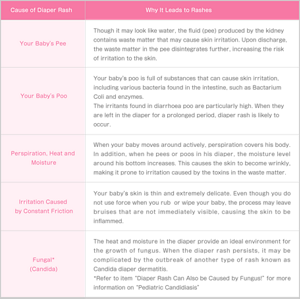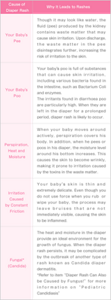- Top
- Information & Tips for Babies and Parents
- Diaper Rash
- Basic Knowledge on Diaper Rash

Diaper Rash
Basic Knowledge on Diaper Rash

Wonder why your baby has diaper rash when you make every effort to ensure it does not happen? Let's understand the causes of diaper rash, so that we can prevent it.
How Do I Know If It's Diaper Rash
Diaper rash is an inflammation that develops in the diaper-covered area. The medical term for this condition is "Irritant Diaper Dermatitis". It causes mild redness and scaling on your baby's bottom, and at times, you'll see an outbreak of spots that resembles heat rashes. The inflammation causes itch and pain, and if the condition worsens, the skin may become sore and may bleed.
The rash may spread outside the diaper area onto the waist or thighs. Skin inflammation around the thighs where the diaper gathers are in direct contact with the baby's skin are also diaper rashes.
Diaper rash differs from heat rash or atopic dermatitis in that the inflammation occurs only in the area where the diaper is in contact with your baby's skin. When the weather is hot, your baby's diaper-covered bottom is prone to heat rash. Hence, you may mistake the heat rash for diaper rash.
Checklist for Diaper Rash
The following are signs of the start of a diaper rash:
-
Your baby appears to be in pain and cries when you wipe his bottom.
-
Your baby cries loudly when you pour warm water onto his bottom during his bath.
-
Your baby tries to scratch his bottom by placing his hand around it after you remove his diapers.
What Causes Diaper Rash?
Diaper rash is caused by a combination of factors. The most common is skin irritation that arises from your baby wearing a wet or soiled diaper for a prolonged period of time. Such hygiene problems may trigger diaper rash.



[A Word of Advice from the doctor]
The skin is endowed with layers of natural defense mechanism that work to prevent irritants from invading the skin. For babies, this defence mechanism is not fully developed. Babies' thin and delicate skin is easily bruised and damaged as their immunity is not fully developed. Furthermore, the younger the babies are, the more frequently they pee and poo, exposing the buttocks to hygiene problems.
When diapers are left unchanged over a long period, the heat and moisture in the diaper cause the skin to crease, making it more vulnerable. The skin can be damaged by merely rubbing against the surface of the diaper. If there is pee and poo in the diaper, the pH level of the baby's skin will rise, increasing its vulnerability to irritants.
In addition, if a baby is wearing diaper or pants that are too tight, the constant friction between the skin and the diaper may cause inflammation.

How do I know it's time to change the size of my baby's diaper?
With the exception on newborns, you should choose the diaper size for your baby according to his weight. Do take note that while two babies may weigh the same, one may be more chubby while the other may be slim and tall. So the other factor that you need to consider should be the fit of the diaper around your baby's waist and thighs.
If you find that the area around your baby's tummy is rather tight (with no space for one finger), and you are already fastening the diaper tapes at the outermost mark, it is time to change your baby's diaper size. If you find marks on your baby's waist and thighs after removing the diaper, it is another indication that your baby has outgrown the current diaper size. It is time to change your baby's diaper to the next bigger size.
Alerts for Diaper Rash
The following conditions increase the risk of an outbreak of diaper rash. Do take special care to maintain the hygiene of your baby's bottom in these situations:
-
When your baby's poo is loose, and the poo frequency increases
- When your baby has diarrhoea
-
When you are not able to change your baby's diaper for a long period of time, such as when you are outdoors or during the night
[A Word of Advice from the doctor]
The performance of disposable diapers today has improved tremendously with quick and efficient absorbency. They absorb fluid instantly and trap it in, keeping the baby's skin dry. As a result, the frequency of babies having diaper rash has dramatically decreased in recent years. However, the diapers cannot absorb solid substances like the baby's poo. If your baby discharges wet poo several times a day, or if your baby has diarrhoea, your baby is highly likely to develop diaper rash. We have to be careful especially in our tropical climate where Rotavirus Diarrhoea is prevalent. This illness can cause prolonged intense diarrhoea and increase the risk of diaper rash for many babies.
Diaper Rash can also be Caused by Fungus!
Besides the skin inflammation caused by heat, moisture and dirt in the diaper, diaper rash can also be caused by fungus. This condition is known as "Pediatric Candidiasis". Skin inflammation in the diaper area is caused by a type of fungus known as "Candida".
Normal diaper rash is usually confined to the diaper area. The distinctive feature of fungal skin inflammation is that it can also be found between the folds of the skin, away from the area that has direct contact with the diaper. The rashes are also beefy red with slightly raised, scaly borders and "satellite" lesions (red lesions appear slightly away from the main rash).
If your baby's diaper rash is complicated by Candida dermatitis, he is not likely to respond to the common diaper rash treatment.
Applying steroid (topical) cream may worsen the condition. Please be extra careful with the treatment. If you apply the prescribed ointment and your baby's skin condition worsens, there is a possibility that the inflammation is caused by fungus. Or your baby may have developed "Irritant Contact Dermatitis" caused by the prescribed ointment itself. Seek medical help when this happens.
[A Word of Advice from the doctor]
When you apply a commonly used diaper rash cream on your baby, you should expect one of these results:
1. Recovers 2. Does not recover 3. Worsens
If your baby's skin condition does not recover, it may be because you are not applying the topical cream correctly. It is also possible that basic hygiene care, including the washing of your baby's bottom, is lacking or not duly practised. If the condition worsens, then it is likely that your baby has developed "Irritant Contact Dermatitis" caused by the topical cream you have applied. It is not uncommon for this to happen.
Vetted by:
Maternity & Gynaecological Clinic
820 Thomson Road, Mount Alvernia Medical Centre, Block A #B1-01, Singapore 574623
- Top
- Information & Tips for Babies and Parents
- Diaper Rash
- Basic Knowledge on Diaper Rash





